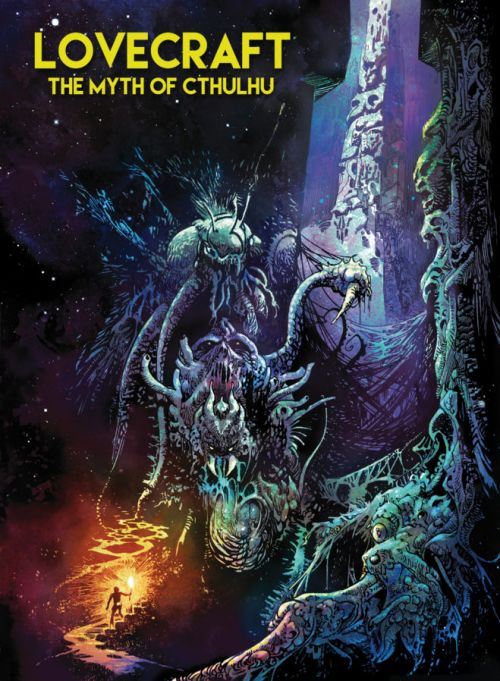Lovecraft: The Myth of Cthulhu comics review
By Leroy Douresseaux
February 25, 2018 - 07:27
IDW Publishing
Writer(s): H.P. Lovecraft, Esteban Maroto, Anna Rosenwong
Artist(s): Esteban Maroto
Cover Artist(s): Esteban Maroto
ISBN: 978-1-68405-125-0
$19.99 U.S., $25.99 CAN, 80pp, B&W, hardcover
 |
| Lovecraft: The Myth of Cthulhu cover image |
Introduction to the Cthulhu Mythos by José Villarrubìa
Prologue and Preface by Esteban Maroto
Esteban Maroto is a Spanish comic book artist. Maroto was the second most prolific contributor to Warren Publishing's line of horror comic book magazines (Creepy, Eerie, and Vampirella) and worked for the publisher from 1971 to 1983. Many fans may remember Maroto as the artist on DC Comics' seven-issue miniseries, Atlantis Chronicles, or perhaps for designing the “metal bikini” worn by Marvel Comics' Conan the Barbarian character, Red Sonja.
Howard Phillips Lovecraft, better known as H.P. Lovecraft (1890 – 1937) was an American writer of horror fiction. After his death, Lovecraft's writing became hugely influential and some critics, historians, and writers now regard him as one of the most significant 20th-century authors not only in the horror genre, but also in literature in general.
Back in the early 1980s, a Spanish publisher (Editorial Bruguera) planned a series of comic book adaptations of classic short stories from the science fiction, fantasy, and horror genres. Asked to contribute, Estaban Maroto decided to adapt three of H.P. Lovecraft stories that were part of a story cycle now known as “the Cthulhu Mythos.” Those stories were “The Nameless City” (first published in the November 1921 issue of the amateur press journal, The Wolverine); “The Festival” (initially published in the January 1925 issue of seminal pulp magazine, Weird Tales); and “The Call of Cthulhu” (first published in Weird Tales, February 1928).
Bruguera went bankrupt before publishing Maroto's three Lovecraft tales. According to Spanish comic book artist and colorist, José Villarrubìa, the stories were eventually published in a Spanish children's comics magazine (Capitán Trueno). In 2000, defunct American publisher, Cross Plains, published Maroto's stories with a new script written by legendary comic book writer and editor, Roy Thomas. In 2016, Spanish media company, Editorial Planeta, SA, published Maroto's Lovecraft stories in an edition that satisfied Maroto and was entitled, Los Mitos de Cthulhu de Lovecraft.
Now, IDW Publishing is releasing an American edition of Los Mitos de Cthulhu de Lovecraft as a hardcover book under the title, Lovecraft: The Myth of Cthulhu. It sports a full-color cover with the interior art reproducing Esteban Maroto's comics art in its original black and white.
THE LOWDOWN: Esteban Maroto! H.P. Lovecraft! I'm all in! Lovecraft: The Myth of Cthulhu is the latest entry in IDW Publishing's catalog of gorgeous hardcover original graphic novels, comics art books, and trade collections. These books are so fine that they are worthy of being sexed-up. Seriously, Lovecraft: The Myth of Cthulhu is a gorgeous book, and I cannot stop looking through it.
As for the contents, Maroto's adaptations of Lovecraft are... well... lovingly crafted. Almost decades after their creation, these comics are like treasures from comics days of yore, but they are also still vibrant in their design and conception and unsettling in the narratives they hold.
“The Nameless City” is a travelogue that I can best describe as blending Lovecraft with director Paolo Sorrentino's 2013 film, The Great Beauty. It is as if the protagonist is traveling through the hideous beauty of the declining elder gods bourgeoisie. In this story, Maroto's art is highly detailed, but the subject matter is impressionistic rather than literal. Some observers have argued that the horror of Lovecraft’s fiction is that the reader visualizes the horror in his mind, rather than have an artist show them what that “Lovecraftian” horror looks like.
That observation is evident in the shadowy, misty, dream world of “The Festival.” Here, Maroto art is sparse and elaborate at the same time. It is as if the artist is creating a realist portrait of a surrealistic and nightmarish shadow land. Crosshatching and line work emanate from buildings and walls like aurora borealis from a shimmery world that could just as easily be Hell or an other-dimensional Hades.
Maroto's blend of the literal and the impressionistic, of the dreamlike and of the waking nightmares culminates in “The Call of Cthulhu,” a masterpiece of a story within a story within a story. In Maroto's graphical storytelling, the high art of Hugo Pratt meets the madness of Graham Ingels in a story that gave me chills by the time the last ten pages slithered before me. The story's dark, inescapable destiny is visualized, so, yes, the graphics of the comics mediums can match the horrors that the reader's mind might fashion out of the end of “The Call of Cthulhu.”
I can only imagine what might have been if the original solicitor of this work had not gone bankrupt so early in the process of its project to adapt classic genre short stories into comics. What Esteban Maroto did give us, however, is a graphics masterpiece of horror storytelling, so I appreciate what we do have all these years later. Thank you, IDW.
I READS YOU RECOMMENDS: Fans of H.P Lovecraft, of Warren Publishing, and of horror comics must have Lovecraft: The Myth of Cthulhu.
A
9 out of 10
Rating: 9/10
Related Articles:
Lovecraft: The Myth of Cthulhu comics review
Lovecraft Country book review
Howard Lovecraft and the Kingdom of Madness
New H.P. Lovecraft's works adaptation coming up from Transfuzion Publishing
Graphic Classics: H. P. Lovecraft
